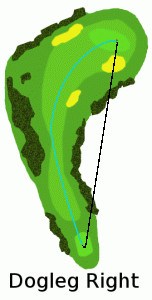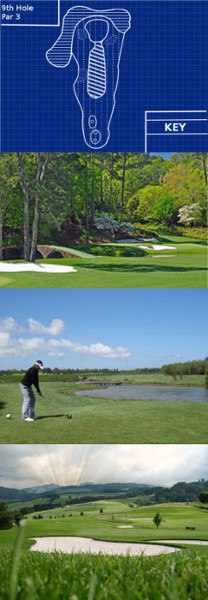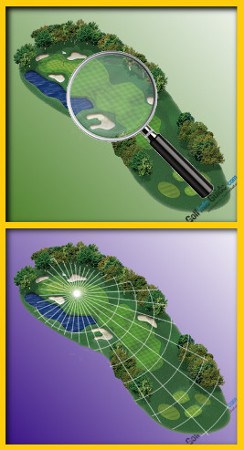
At first glance, golf doesn't seem to involve much strategy. See ball, hit ball, until you get it in the hole, right?
True enough. But there are strategic elements built into virtually every golf hole. Understanding basic design concepts can help you navigate the course efficiently and shoot lower scores.
The most important design fundamental to understand is this: The closer to trouble you play one shot, the easier your next shot will be. The converse is also true: Play safely away from harm and you'll face a more difficult challenge with your next swing.
To illustrate, let's take a par 4 that doglegs (curves) to the right:
- Drawing a straight line between the tee and green you'll cross the rough, and possibly trees or hazards like sand and water. Veer down the hole's left side and you find a wide expanse of fairway, with peril well to the side and easily avoided.
- Naturally, the straight path is the shortest, but brings a measure of risk. The golfer who takes on the risk and succeeds by finding the fairway earns a shorter approach shot, likely without a hazard to carry and lots of room on the green.
- The wide-left route is safer, of course, but leaves a longer second shot. Architects will often place greenside hazards in the line of approach from this angle, or shape the green to make it more difficult to hit and hold.

Understand Course Design to Play Strategic Golf
When playing golf, you don't have to go up against a defense as you are forced to do in most other sports. In basketball, for example, you have to work your way around the five players on the other team in order to score points. The story is the same in football, except there are 11 defenders to navigate rather than just five. Basically, any sport that is contested by two teams requires the team on offense to deal with the defense in front of them if they wish to be successful.
Golf, of course, is different. While you will usually be playing with other people while on the course – and you may even be competing against those players – there is nothing they can do to stop you from playing your best. The rules of golf don't allow for defense to be played, so you will be able to make your way around the course without having to worry about your competition getting in the way.
Thinking about it this way, golf should be pretty easy, right? With no one playing defense, shouldn't you be able to just knock the ball right up next to the hole time after time? Not so fast. Just because the other players on the 3course aren't playing defense doesn't mean that there is no defense at all in front of you. In this game, the defense comes in the form of the course itself. The layout of the course has been created specifically to present you with challenges along the way. In order to post a good score, you have to successfully recognize, and deal with, the defense that the course has to offer.
Most golfers don't think of the game this way. The average player tends to largely ignore the design of the course they are playing, instead focusing on their own swing and their own game. While there is nothing wrong with paying attention to your technique, you have to be sure to also think about the course in front of you, as it has a great deal to do with the kinds of shots you can use to get the ball close to the hole. Course design is an important piece of the overall golf puzzle, so spending time thinking about how design affects your game should help you post lower scores moving forward.
In the content below, we are going to take a closer look at some of the ways you can use the design of the golf course to your advantage. Most golf courses can be conquered when played the right way – but you have to determine just how to play them, and then you have to execute properly throughout the round. If either part of that equation is missing – the strategy or the execution – you aren't going to be able to play up to your potential. Playing strategic golf might take a bit more effort than just swinging away on every shot, but it will be worth it in the end.
All of the content below has been written from the perspective of a right handed golfer. If you happen to play left handed, please take a moment to reverse the directions as necessary.

Some Basic Strategy Keys
For an experienced golfer, there are some basic strategy keys that have to do with course design which are basically 'no-brainers'. In other words, an experienced player probably doesn't have to worry about the points below, because they understand them fully thanks to the years they have spent on various courses. However, if you don't have that kind of experience in your past, you may not be able to automatically navigate your way around the following design features. Review the list below and commit these points to memory – they are sure to come up more than a few times in the rounds that you play over the years ahead.
- Find the landing zone. On most golf courses, the par fours and par fives include a 'landing zone' which is going to be the most-welcoming part of the fairway for your golf ball. Unfortunately, this zone isn't always located at a convenient distance for your driver. As you stand on the tee of any par four or par five, take a look at the fairway and decide where you would like to place your ball to give yourself the best chance at winding up in the short grass. Can you hit a driver, or should you club down to a three wood or hybrid? Don't force your game upon the course – let the course dictate the strategy that you take. When you play toward the biggest landing zone available, you will be maximizing your chances to hit the fairway.
- Don't be tricked by a false front. One of the common features used in green complexes by course designers wishing to trick golfers is the false front. Simply, a false front is a section of the green that is too steep to actually hold the ball. So, from the fairway, you will see the front of the putting surface and think that you can get your ball to that position in order to set up a putt. However, when your approach lands on the false front, it will simply roll back off the green and you will wind up chipping for your next shot. When you suspect a false front may be in play, add a few yards to your approach shot to safely clear this subtle course design trick.
- The lure of the short par four. Course designers love to include short par fours as a way to entice you to take the driver from the bag and go for the green. However, more often than not, the best play is going to be laying up when a par four is right on the edge of your range. Why should you lay up? Basically, you don't want to turn what should be an easy hole into a disaster. If you lay up on a par four of less than 300 yards, you will have a great chance to make a par, if not a birdie. However, if you go for the green, you will bring all kinds of potential trouble into play. A wayward drive could leave your ball in a bad spot, making a bogey or worse a possibility. Keep the ball in play, lay up to a comfortable wedge distance, and make sure you walk off the hole with no worse than a par.
- Slopes are your friend. You might look at the slopes included on a golf course as an obstacle that needs to be conquered, but they are actually your best friend when used correctly. Playing your short shots uphill is a huge advantage over having to play downhill, so you want to do your best to position your ball on the low side on or around the green. By consistently being able to chip or putt uphill, you will always have a good chance to get down in two. As you are planning your approach shots into the greens, always figure out where the low side is so you can use it to your advantage time after time.
Of course, the four points above are just a drop in the bucket of overall golf course strategy, but they are a great place to start. If you can take these points to heart and use them during your upcoming rounds, you will instantly find yourself to be a better player. There is more to learn, including what is to be found in the sections below, but this short primer on some of the key course strategy tips will take you a long way.

Determining the Theme of a Course
Most golf courses are designed around a basic theme that will be carried throughout the layout. From the first hole on through to the last, there are going to be design elements that are featured over and over again. Unfortunately, the theme of the course isn't likely to be posted outside of the clubhouse door. Rather, you are going to have to determine the theme for yourself based on what you find as you play. The faster you can figure out what each individual course is all about, the sooner you will be able to shoot low scores.
Even before you head out to the first tee, you should be able to pick up some clues as to what the course is all about. Are there trees all around the property? If so, you can safely assume that the trees are going to be a major part of the defense of the course. On the other hand, if you are on a property without a tree in sight, the designer will likely have used a number of other hazards like water and sand to present you with challenges.
On a tree-lined course, you will need to have great control over your golf ball in order to score well. Positioning your ball off the tee is going to be incredibly important, as it will be possible to block yourself out on dogleg holes when you are in the wrong position and trees are in your way. When playing a course that has no trees, however, you won't need to worry as much about angles because you will always have open airspace to work with. The bigger concern from a strategy standpoint on a course that doesn't feature trees is to keep your ball safely out of the hazards. These kinds of courses usually have more hazards to make up for their lack of trees, so you want to steer clear of the water and sand as often as possible to keep your score on track.
Another issue to think about is the size of the fairways and greens. Are you going to be given ample landing areas all day long, or will accuracy be at a premium? On courses with wide fairways, you will want to pull your driver from the bag hole after hole in order to maximize your distance. Obviously, this is a strategy that will need to change when you find yourself on a narrow course. With tight fairways and little margin for error, club down from the tee and focus on keeping the ball safely in play. This is where it is important to be flexible and adaptable based on the course in front of you – rather than being a player who is always aggressive or always conservative, you want to be a player who can quickly change styles to suit the course at hand.
One last point that should be taken into consideration with regard to a course's theme is the climate of the surrounding area. This is something that you will have no problem factoring in when you are close to home, but it might be a bit trickier if you have traveled to play golf somewhere new. Think about the prevailing weather in that area, and what that will mean for the golf course. Naturally, places that are usually warm and dry will tend to feature firm, fast courses, while damp climates lead to courses that are soft with very little roll. As you are putting together your strategy for the day, think about the way the climate is going to affect your game, and what that means for how you are going to attack each hole.

Rationalizing Your Fears
Many of the hazards that are put into place on a golf course are used to create fear in the minds of the golfers. When you stand over the ball, you want to feel confident about the shot you are going to hit – after all, confidence tends to lead to great golf swings. However, when you know there is a hazard lurking near your target that is waiting to catch a poor shot, you might find yourself feeling more fearful than confident. One of the ways that you can use strategy to improve your game is by thinking rationally regarding the hazards that you face. Some hazards do demand fear and respect, while others really aren't that big of a deal.
With this in mind, the list below is going to outline some of the potential hazards that you can face on the course. Golfers tend to think about all different kinds of hazards in the same way, but that is a mistake – some are far more punishing than others. You can afford to be aggressive in the face of some hazards, while others should be avoided at all costs. Use the list below to gain a better understanding of how you should think of the hazards that course designers use to put fear in the back of your mind.
- Greenside bunker. One of the most-common types of hazards, the average greenside bunker should not put much fear into your mind. When your ball lands in a greenside bunker after an errant approach shot, you will still have a good chance to save your par – and you should be able to escape with nothing worse than a bogey (unless you happen to draw a terrible lie in the sand). While you would obviously prefer to keep the ball on the short grass rather than knocking it in the sand, a simple greenside bunker shouldn't make you think twice about your shot.
- Lateral hazard. Hazards that are marked with red stakes – whether they contain water or not – are considered 'lateral hazards'. These types of hazards come along with a one-stroke penalty, and you have to drop your ball near the point of entry (or use one of a couple other options). In most cases, these hazards will not be too damaging to your score, as you should be able to drop the ball in a decent position from which to recover. Unless there is a particular reason to think that a given lateral hazard will cost you more than just one stroke, you can still be relatively aggressive around this kind of trouble spot. Sure, keeping your ball out of the lateral hazards would be best, but hitting one shot beyond the red stakes isn't going to totally derail your round.
- Water hazard. When you find yellow stakes on the golf course, those are designating a water hazard, which is different from a lateral hazard in a number of ways. While we won't get into the specifics of the rule book at this point, it is safe to say that water hazards tend to be more punishing than lateral hazards when it comes to your score. You have fewer options for your drop from a yellow hazard, meaning you may have a tough shot left even after taking your penalty. As far as your strategy goes, you will want to exercise far more caution when playing over or near a water hazard as opposed to a lateral hazard.
- Out of bounds. This is the most dangerous type of hazard (it is not technically a 'hazard' under the rules, but the idea is the same), and one you will want to avoid at all costs. The penalty for hitting your ball out of bounds is stroke and distance, meaning you add a stroke to your score and play the shot again from the same place. Obviously, this is extremely damaging to your score. It is rare to get away from a hole where you hit the ball out of bounds with less than a double bogey, and your score may even rise higher than that. When you see out of bounds lurking somewhere near your target – marked with white stakes – you will want to be extremely careful and do your best to play your shot away from those stakes.
It should be noted that areas where you may lose your ball should be approached with the same kind of caution as out of bounds, even if there aren't any stakes present. If you lose your ball in an area that is not staked, the rules require you to return to the site of the previous shot to play again – after adding a stroke to your score.

Understand the Green Complexes
As you already know, a big part of your score for any given round of golf is going to be decided by your putting. If you putt well, you can make up for some 'so-so' ball striking. On the other hand, putting poorly is sure to ruin your score, even if you hit the ball great. So, it only stands to reason that your analysis of the golf course should not be limited to the full swings you make, but it should also extend to the greens.
When walking up to the green, take a moment to evaluate the layout of both the green itself and the surrounding area. Where is the lowest spot around the green? All greens have to be designed in a way that will move water off of the surface and into the drainage, so think about how that drainage has been designed to work. When you can find the point on the side of the green where water is supposed to drain, you will have a good idea of which way your putts are going to break. Using small clues like this to your advantage can mean great things when it comes to your short game performance.
Understanding how the design of a golf course affects your game is one of the key things you can learn as a golfer. Many players simply walk out onto the course and start swinging, but that approach is always going to lead to less-than-ideal results. Don't make the mistake of taking such a casual approach to your game. Think about the design of the course, identify the strengths and weaknesses of the design, and then use your game to the best of your ability to post good scores on each hole. All courses can be conquered with the right combination of strategy and execution, so be confident and look forward to performing at your best.






